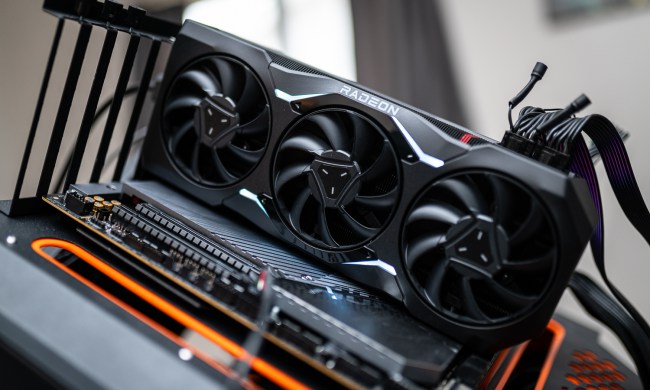 AMD
AMD
AMD might really go all out during CES 2025 this January. According to a known leaker on the Chiphell forums, AMD is readying a slew of consumer products, ranging from more X3D desktop CPUs to handheld chips and RDNA 4 graphics cards. Here’s what we have to look forward to.
The tantalizing bit of gossip comes from Zhangzhonghao, a leaker who’s been known to discuss new releases ahead of time. Starting with laptops, AMD is reportedly set to release next-gen Kraken (or “Krackan” as referred to by this leaker) Point APUs alongside Ryzen AI Max (or Strix Halo), and lastly, Fire Range CPUs.
That’s a lot of different product ranges, so for a quick refresher, Kraken Point is expected to be the successor to AMD’s current Ryzen 8040 series. Leakers claim that it’ll come with up to four standard Zen 5 cores and four Zen 5c cores as well as RDNA 3.5 graphics with up to eight compute units (CUs).
Get your weekly teardown of the tech behind PC gaming
Strix Halo processors are more on the high end of the scale, and AMD may launch three laptop CPUs to start with, all under the Ryzen AI Max umbrella: The Ryzen AI Max+ 395 with 16 cores, the Ryzen AI Max 390 with 12 cores, and lastly, the Ryzen AI Max 385 with eight cores. All of them will offer built-in RDNA 3.5 graphics. Fire Range is the successor to Dragon Range and will essentially be the laptop version of Zen 5 desktop CPUs, aimed at high-performance laptops for gamers. Zhangzhonghao also claims that AMD will unveil X3D CPUs for laptops at the same time.
Those on the hunt for some of the best gaming handhelds will be able to look forward to a mix of new chips, including the Ryzen Z2, the Ryzen Z2 Extreme, and the Ryzen Z2G. The Ryzen Z1 Extreme chip powered many successful handheld PCs, so I’m curious to see what kind of improvements AMD will introduce with its next-gen options.
 Zhangzhonghao / Chiphell
Zhangzhonghao / ChiphellThe graphics cards part of the announcement is no surprise: AMD is said to be launching RDNA 4 GPUs during CES 2025. For a long time now, it’s been said that AMD will let Nvidia dominate the high-end portion of the market and will stick to mainstream GPUs with this generation. This could mean a flagship RX 8800 XT, but we’ll have to wait and see.
Lastly, Zen 5 X3D CPUs. AMD itself confirmed that it’ll unveil a new Ryzen 9000X3D CPU on November 7, but it didn’t specify which exact model it’d be. However, most sources expect it to be the Ryzen 7 9800X3D, and this leak only serves to prove that. AMD will follow it up with the Ryzen 9 9900X3D and the Ryzen 9 9950X3D at CES 2025.
This has been a fairly disappointing year for PC hardware. While we’ve had new desktop CPUs from both Intel and AMD, they mostly failed to deliver much in the way of gen-on-gen improvements. GPU enthusiasts endured the greatest disappointment, as out of the three new lineups we’ve expected to see in 2024, not one was actually released. However, it looks like CES 2025 will make it all better, with AMD’s stack of new products and Nvidia’s RTX 50-series said to be announced at the same time.

Monica is a computing writer at Digital Trends, focusing on PC hardware. Since joining the team in 2021, Monica has written…
AMD’s multi-chiplet GPU design might finally come true

An interesting AMD patent has just surfaced, and although it was filed a while back, finding it now is all the more exciting because this tech might be closer to appearing in future graphics cards. The patent describes a multi-chiplet GPU with three separate dies, which is something that could both improve performance and cut back on production costs.
In the patent, AMD refers to a GPU that's partitioned into multiple dies, which it refers to as GPU chiplets. These chiplets, or dies, can either function together as a single GPU or work as multiple GPUs in what AMD refers to as "second mode." The GPU has three modes in total, the first of which makes all the chiplets work together as a single, unified GPU. This enables it to share resources and, as Tom's Hardware says, allows the front-end die to deal with command scheduling for all the shader engine dies. This is similar to what a regular, non-chiplet GPU would do.
Read more
Nice try, Intel, but AMD 3D V-Cache chips still win

Intel's freshly released Core i9-14900KS processor is advertised as the fastest CPU in the world, but does that mean AMD can never hope to compete, even with its flagship Ryzen 9 7950X3D? Not at all. Each CPU has its merits, and both are insanely powerful in their own right. At this price point and at this performance level, making the right choice is tricky.
Let's zoom in and find out how the Core i9-14900KS and the Ryzen 9 7950X3D stack up against each other, what they excel at, and which one is the better option to buy.
Pricing and availability
Read more
I compared all of AMD’s V-cache CPUs to see which you should buy

AMD's Zen 4 3D V-Cache CPUs are true marvels of modern CPU performance. They offer exceptional gaming performance on par with the absolute best that Intel has to offer, and yet do it at a fraction of the power draw and heat output. They lose out on productivity performance, but that's what the non-X3D AMD CPUs are for. And if you want all-rounders, but don't mind high thermal design power (TDP) ratings, then Intel's offerings are always an option.
But out of the latest generation of X3D CPUs, which is the best? The 7950X3D is the most expensive with more cores, while the 7800X3D is the gaming darling. And what about the option between those two, the 7900X3D? Let's find out.
Pricing and availability
Read more





















 English (US) ·
English (US) ·